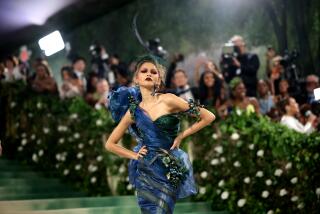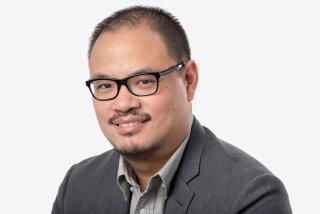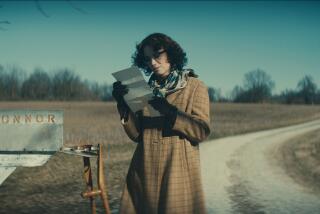A Human Dimension to New Media
Some say that new technology sounds the death knell for face-to-face human interactions--that we’ll all be riveted to our Aeron chairs, staring at the tube. However, it’s the experience of Mark Tribe, founder of Rhizome.org, a New York-based Web site for exploring the intersections of art and technology, that people do like to meet in the flesh.
In Manhattan, Rhizome sponsors popular monthly showings of new media art, called “OpenMouse,” usually at a bar where tech-art fans can schmooze afterward.
“We wanted to take it out of the academic or institutional setting, these works were so dynamic,” says Tribe. “People like to meet each other, to talk, to hang out.”
Now the concept, in a slightly different package, is coming to L.A. Beverly Tang, a lamp designer, technophile and, like Tribe, a graduate of art school at UC San Diego, is the producer of Rhizome.LA, a new media art salon that will take over the newly opened Whose Cafe on Santa Monica Boulevard one night a month. On Wednesday, six artists, mostly of the computer-wielding variety, will present and discuss their work to kick off the series. Rhizome will provide, among other support, a Web presence at www.rhizome.org and an electronic mailing list.
“I’ve been following new media art and knew that there are a lot of projects out there that aren’t seen very much,” Tang says. “Galleries don’t really show a lot of new media--it’s hard for them to present it. It’s not like a painting that they know how to hang.”
Another problem is commercial: Many pieces aren’t meant to be sold, and in any case, the market for such works is small. Part of that is due to newness; part is due to what Tang calls “problems of the future--like, is there tech support for the art when things break down?”
All of which makes show-and-tell a better way to go, she says.
Tang asked Tribe to connect the new series to Rhizome. “We have similar ideas of community,” Tang says, “and it was obvious we could easily collaborate on this.”
“What’s happening in L.A. is the paradigm for how we want to do things in the future,” Tribe says. “We’re here to help Beverly, provide some infrastructure to make it possible. And we want to replicate that in cities around the world.”
Rhizome.LA, as Tang points out, won’t be pushing a new media style or movement. There isn’t one, she says. But there are some commonalities.
First, Tang says, the artists are often using materials and processes created for industrial applications, not for the making of art, so artists have to be inventive in turning them to their own ends.
Secondly, the element of unpredictability or randomness is often part of the process. “You could say the artists have less control over their product and allow everything to interact,” she says. “They play more with chance, as opposed to traditional art, where they have more control.”
The salon’s kickoff artists, recruited by Tang, are Steve Appleton, Joyce Campbell and Mark Pesce, all of Los Angeles, Scott Draves and Nick Thompson of San Francisco, and Ryan Wartena of Atlanta.
They have vastly different projects and portfolios. Some are technically trained, with degrees and day jobs in computer science; some have fine-arts backgrounds.
And for some, working in new media doesn’t involve using a computer. Campbell, for instance, uses morphogenesis--chemical and biological structural development--as her subject, and photography as her medium. She has a background in sculpture, and she has been commissioned by the Southern California Institute of Architecture to chart L.A. in her own particular way. She’ll introduce Rhizome.LA attendees to “Bloom,” which is in the beginning stages, and is similar to work she did in Australia and New Zealand, before moving to L.A. two years ago.
For “Bloom,” which will be part of a mapping exhibition when it is finished, Campbell has begun collecting water and soil samples from 50 sections of Los Angeles County. “I’m trying to be relatively empirical about it,” she says. “It’s absolutely pseudoscience, but I have to maintain quite a strict protocol to make it meaningful in any way at all.”
Each sample will then be cultivated in much the way science labs grow viruses or bacteria. A bit of it will be placed on agar spread across a sheet of plexiglass; agar is that gelatin-like stuff in the bottom of your high school petri dish. After letting the samples stew for several days, Campbell will create a photogram of the results--directly transferring their images onto positive photographic paper.
It will be intriguing to see how the samples differ from area to area, she says.
“I’m interested in how habitation registers itself on space, in self-generating form, and the idea that meaning can be projected onto form,” she explains.
Another of the locally created projects seems on the face of it more like old media than new. Mark Pesce and photographer Steven Piesecki are finishing an hourlong video of this year’s Burning Man Festival, which took place in August in the Nevada desert about 130 miles northeast of Reno.
But Pesce and Piesecki are using a digital process, which makes their work startlingly cheap to produce--about $3,000, which includes digital camera equipment and tape stock, and editing and special effects can be done through the friendly home computer.
The filmmakers will screen an excerpt from “This Strange Eventful History” that focuses on one construction at the festival, whose overall theme this year was the Seven Ages of Man. “The Temple of Tears,” an ethereally lacey building made of press board, addressed the subject of death and was burned at the end of the event, which is dedicated to radical self-expression.
“The idea is not to document,” Pesce says. “I wanted to make an artistic piece about this one piece and the festival.”
As a result, the video skips narration and interviews, and communicates strictly through imagery and music (which is by Todd Barton). Pesce hopes to screen the film at Burning Man next year and at film festivals, and he is also planning a DVD with optional commentary.
The works of Appleton and Draves may be closer to what you would expect from the intersection of technology and art. Both require computers, and both make use of that element of chance that often marks new media art.
Appleton’s “About Face,” which he’ll demonstrate Wednesday, uses a surveillance-type camera and form-recognition software. The program captures images of people’s faces and eventually reduces them to components of a larger face.
There are two levels of randomness in his work, he points out. “One is the randomness that happens that you simply don’t expect, which can be disconcerting or surprising and interesting”--such as when the computer reads an eye as a whole face.
“Then there’s another that you deliberately put into the program.” He points to one of his printouts of a grid of faces and explains how the computer randomly changed the background colors each time the screen was regenerated.
Draves, a programmer from San Francisco, has devised a screen saver that links computers to create ever-changing animated images that he calls “Electric Sheep” (from Philip K. Dick’s story “Do Androids Dream of Electric Sheep,” the inspiration for the film “Blade Runner”). Sample “sheep” (which may be seen on www.electricsheep.org) can look like crystalline structures, colored wisps of smoke or nebulae spinning in space--programmed, but not predetermined, by Draves.
Thompson’s work is also a program: “Glambient” explores families of “tilings,” allowing the user to change the shapes and relationships among the pieces.
Finally, Wartena is interested in updating old science with new. He is working on using laser technology on vinyl to create improved analog (as opposed to digital) audio records, perhaps even adding a visual component.
The Rhizome.LA series is designed to be ongoing. Tang already has January and February planned.
The second salon will feature a disc-scratching robot deejay, which is the creation of MIT Professor Chris Csikszentmihalyi. At Whose Cafe, “DJ I, Robot” will collaborate with local sound artists. In February, more robotics are planned--robots used in art, entertainment and maybe even medicine.
And somewhere down the line, there will be new media in fashion--built-in gadgetry, new fibers, new designs.
From Tang’s perspective, new technology isn’t necessarily being invented for the sake of aesthetics. But, she says, “with all these breakthroughs, it’s a waste not to use them for artistic purposes.”
*
“RHIZOME.LA,” Whose Cafe, 6320 Santa Monica Blvd., Hollywood. Dates: Wednesday, 7:30-10 p.m. Price: Free. Phone: (323) 462-8500.
*
Scarlet Cheng is a regular contributor to Calendar.
More to Read
The biggest entertainment stories
Get our big stories about Hollywood, film, television, music, arts, culture and more right in your inbox as soon as they publish.
You may occasionally receive promotional content from the Los Angeles Times.






